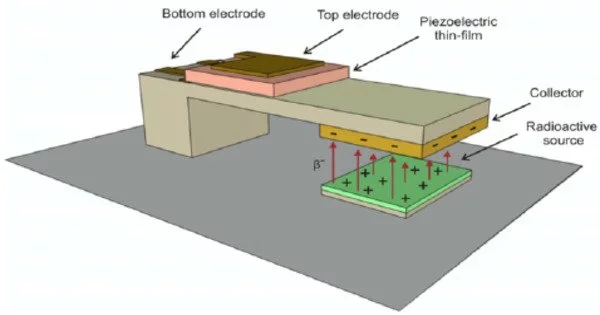A radioisotope piezoelectric generator (RPG) is a type of radioisotope generator that uses the repeated deformation of a piezoelectric material to generate electricity by converting energy stored in radioactive materials into motion. It is a device that uses the piezoelectric effect to convert the energy released by radioisotope decay into electrical energy. This method produces a high-impedance source, and unlike chemical batteries, the devices can operate at a wide range of temperatures.
The radioisotope used in such generators is typically a radioactive material that decays and emits particles such as alpha, beta, or gamma radiation. Energy is released during the decay process in the form of radiation, which can be used to generate electricity.
Description
The piezoelectric effect is a phenomenon that occurs when certain materials, such as crystals or ceramics, are subjected to mechanical stress or pressure. The radioactive decay of isotopes generates high-energy particles that strike a piezoelectric material, causing it to vibrate or deform in the case of a radioisotope piezoelectric generator. Mechanical stress or pressure causes an electric charge to be induced on the material, which can be collected and converted into usable electrical energy.
A piezoelectric cantilever is suspended directly above the radioactive isotope nickel-63’s base. The only radiation emitted as the millicurie-level nickel-63 thin film decays is beta radiation, which is made up of electrons. As the emitted electrons accumulate on the cantilever, it gains a negative charge, while the isotope film gains a positive charge. In essence, the beta particles transfer electronic charge from the thin film to the cantilever.
The cantilever bends toward the isotope film due to the opposite charges. The charge jumps the gap just as the cantilever touches the thin-film isotope. This allows current to return to the isotope, balancing the charge and resetting the cantilever.
The tiny cantilever will continue to move up and down as long as the isotope decays, which can take decades. Because the cantilever generates electricity when deformed, a charge pulse is released each time it cycles.
Radioactive isotopes can continue to emit energy for weeks or decades at a time. Nickel-63, for example, has a half-life of more than 100 years. As a result, a battery containing this isotope may continue to provide useful energy for at least half that time. Researchers demonstrated devices with approximately 7% efficiency ranging from high frequencies of 120 Hz to low-frequency (every three hours) self-reciprocating actuators.
Radioisotope piezoelectric generators have been considered for a variety of applications, particularly those requiring a long-lasting and compact power source. They have been proposed, for example, for powering remote or autonomous devices like deep-sea sensors, space probes, or implantable medical devices. To ensure a stable power output over an extended period, the radioisotope used in these generators should have a long half-life.
Because of the potential hazards associated with radioactivity, the use of radioisotopes in power generation comes with significant safety considerations. To prevent any harm to humans or the environment, strict protocols and regulations are in place to ensure the safe handling, transport, and disposal of radioisotopes.
















